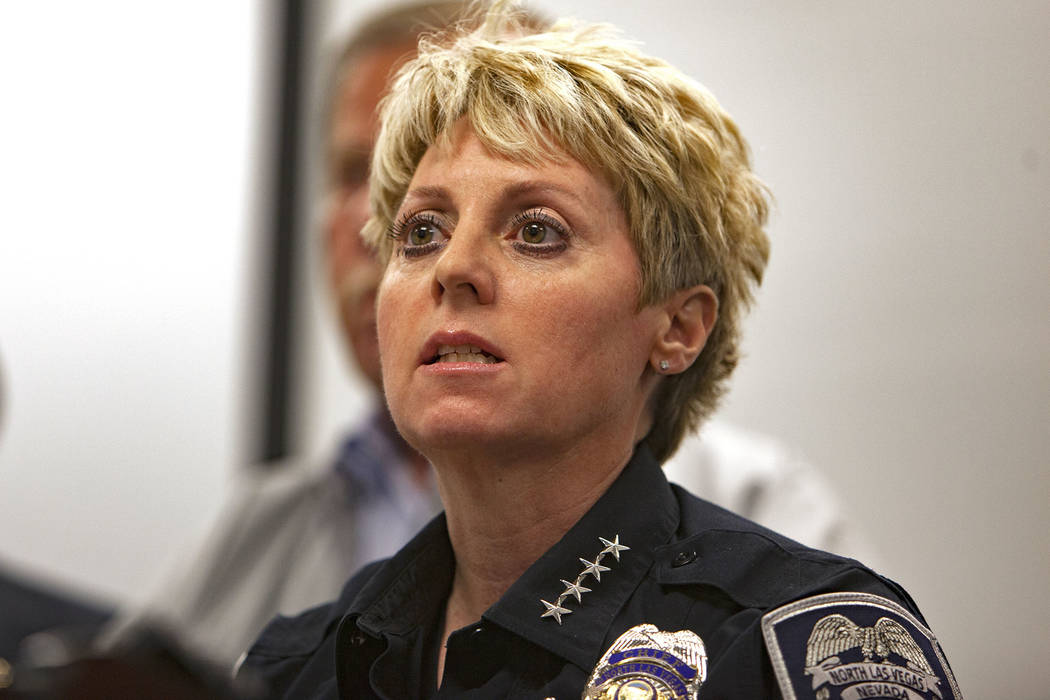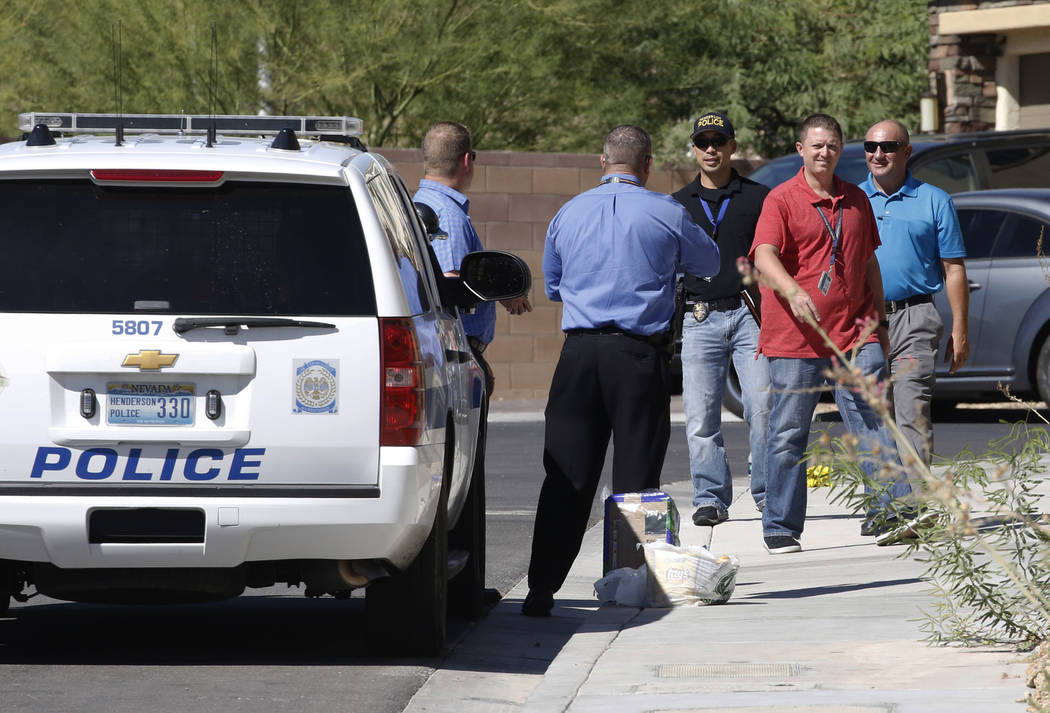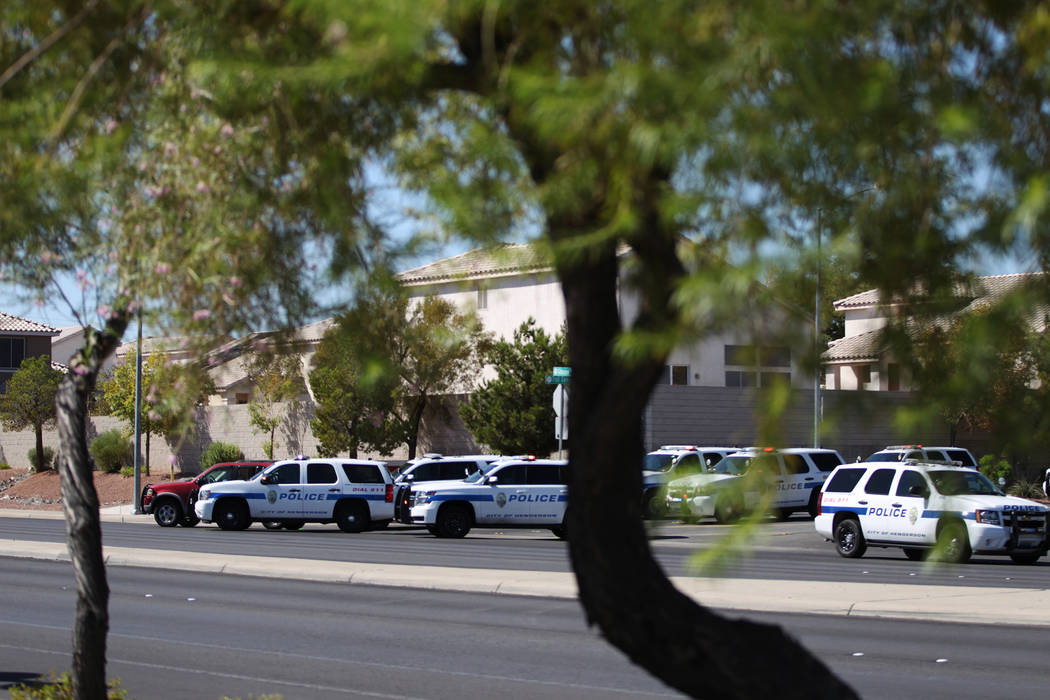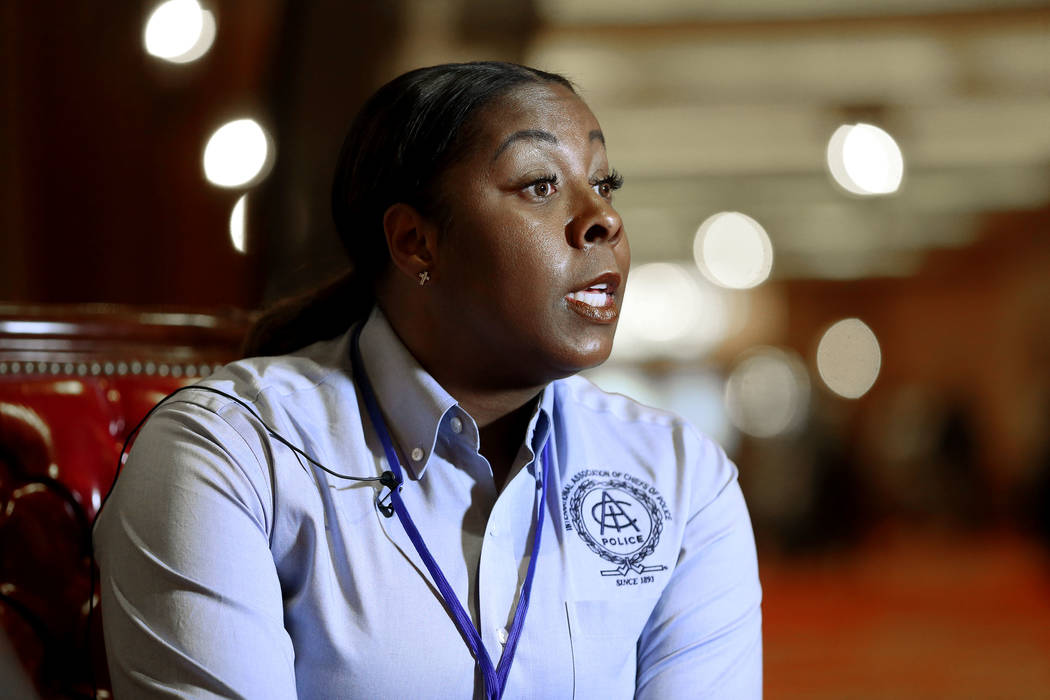North Las Vegas police yet to deploy state-required body cameras
Eight months after a state deadline requiring police departments to outfit forces with body cameras, North Las Vegas officers still do not wear the devices.
The law, Senate Bill 176, was enacted in 2017 and required officers who regularly interact with the public to wear the cameras by July 1, 2018.
The Las Vegas Review-Journal is spotlighting the body-camera law as part of Sunshine Week, an annual observance of the public’s right to government records and information that keeps agencies accountable. Body-camera footage is by law a public record and has made police agencies more transparent.
Police shootings on Halloween and in January highlighted the fact that North Las Vegas Police Department officers weren’t yet outfitted with the devices. The department held news conferences following the shootings but was unable to show body-camera footage.
Chief Pam Ojeda said she expects her officers will be fully equipped with the devices by late April or early May.
“We wanted to make sure we found the best product and the best value for our tax dollars,” Ojeda said. “Though it took us a little long, we wanted to make sure we took our time.”
The Henderson Police Department also failed to meet last July’s deadline but fully outfitted its officers by late August, said Lt. Isaac Henn, who oversees the department’s training and development.
That both departments failed to equip officers by the deadline sent the wrong message to the public, longtime civil rights activist and former ACLU of Nevada Executive Director Gary Peck said. Such delays also can hurt officers who may have been accused of misconduct and could potentially have been exonerated by body- camera footage, he said.
“It’s not up to law enforcement agencies to decide whether or not body cameras are a priority,” Peck said Wednesday. “The Legislature decided that for them, and the Legislature reflects the will of the people.”
Policy questions
Even with the cameras, questions have arisen about how forthcoming Henderson police have been in releasing footage and information following officer-involved shootings.
The department has had three such shootings since August. After two of them, police released a total of 46 seconds of body-camera footage and sent news releases at 8:52 p.m. and 8:56 p.m. on Sept. 28 — a Friday — several days after both shootings.
Lt. Kirk Moore, from Henderson’s public information office, said police have created a new officer-involved shooting and critical incident policy that is under review by the city attorney’s office. The policy would govern how police investigate the shootings and how information would be released to the public.
“Our desire is to remain transparent while balancing the public’s interest, the integrity of the investigation and the citizens involved,” Moore said in a statement.
Tara Huffman, director of the Open Society Institute-Baltimore’s criminal and juvenile justice program, said footage provides more insight into the events of a police encounter.
However, it’s increasingly apparent that footage “doesn’t tell the story in as black-and-white terms as everybody thought it might,” said Huffman, who has advocated for police reform.
Along the same lines, she said, police often distrust the public’s understanding of their jobs and could have a “knee-jerk reaction” to the idea of releasing footage without first studying what story it tells.
Leaving the public to its own interpretation of footage is “nightmarish” for police, who may fear negative perceptions of their actions, Huffman said.
“That is like hell for police departments,” Huffman said.
In an October interview with the Review-Journal, Henderson Police Chief LaTesha Watson acknowledged the importance of transparency but questioned the need to release lengthier amounts of body-camera footage when pressed on the subject.
“Where are you getting that it should be a lot of seconds of video?” she said. “I’m still not drawing the alignment that because you have officers who have body-worn cameras, and there is a shooting, that it should be so many seconds of stuff released. I’m not understanding.”
Watson was placed on administrative leave for undisclosed reasons on Thursday.
Police released about 26 seconds of footage from the Sept. 13 fatal shooting of a box cutter-wielding man and 20 seconds from the Sept. 22 deadly shooting of a man following a foot chase. Both clips cut off before officers pulled the trigger.
In the fatal shootings, Watson said, the department determined showing the shooting itself wasn’t warranted. Watson said her department values transparency but also sensitivity toward the families of those who died.
Prior to body cameras, the public often was left to rely on police or witness accounts of police encounters, ACLU of Nevada Executive Director Tod Story said. The ACLU supported the 2017 bill because camera footage can provide the public the chance to draw its own conclusions.
“It doesn’t mean we’ve always liked what we’ve seen,” Story said. “But now we have the video.”
Story questioned why Henderson police would release minimal footage “under the cover of darkness” on a Friday night, adding that doing so doesn’t align with the spirit of transparency and the law.
“The whole point of the law is to default to transparency,” he said.
Huffman echoed Peck’s comments about the message it sends, while acknowledging police concerns that purchasing the equipment and maintaining footage can be expensive.
“All of that comes with a price tag,” she said.
North Las Vegas rollout
Last month, the North Las Vegas City Council approved a five-year, roughly $1.5 million contract for body cameras and recording devices for patrol vehicles.
The department should begin rolling out the cameras “any day now,” police spokesman Eric Leavitt said.
Leavitt attributed the delay partly to efforts to choose the equipment and find funding for the purchase and footage storage. The law did not provide agencies with funding but allowed an increase in surcharges to pay for equipment and any maintenance associated with the camera systems.
The department wasn’t trying to delay getting the cameras, Leavitt said, acknowledging that the process took longer than expected.
“There was never a time we stopped trying,” Leavitt said.
hose who supported the bill when it was introduced remained skeptical. Story said that the department should provide a better explanation to the public why it didn’t make the deadline.
“I can’t understand why anyone would claim they were not able to adopt the technology by the deadline,” given the surcharge language in the bill, he said.
Penalties
The law did not specify repercussions for failing to meet the July 1 deadline, and neither department was penalized for tardiness.
“Although they mandated July 1, they did not provide any funding or anything like that, so we never had any contact with them or anything,” Ojeda said.
Attorney General Aaron Ford sponsored the body-camera bill while serving as a state senator. When asked for comment, his office sent a statement in late January.
“Attorney General Ford looks forward to working with newly appointed North Las Vegas Police Department Police Chief Ojeda to ensure compliance with the body-worn camera law,” the statement read. “He is confident that the department will take the necessary steps to outfit their officers with these cameras.”
All 33 eligible officers from the Boulder City Police Department were outfitted with the cameras by the July 1 deadline, city spokeswoman Lisa LaPlante said.
“We made sure that we fell into compliance with the date which they were required,” LaPlante said.
The law expanded upon one passed in 2015 that required Nevada Highway Patrol troopers to wear the devices. In 2014, the Metropolitan Police Department became one of the first major police departments in the country to outfit its officers with body cameras.
Once outfitted, North Las Vegas police plan to release body-camera footage at news conferences held within 72 hours of their officers’ shootings, similar to “the Metro model,” Leavitt said.
Contact Mike Shoro at mshoro@reviewjournal.com or 702-387-5290. Follow @mike_shoro on Twitter.
Body-worn camera policies
North Las Vegas' policy guiding its body camera use has been written but is in the process of being legally reviewed and finalized, police spokesman Eric Leavitt said. The department collaborated with Henderson and Metro when putting together the policy, which Leavitt said was not yet publicly available.
The Henderson Police Department provided a copy of its new body-worn camera policy, which Henn said was crafted after the purchase of the new cameras. Henderson's policy shares several similarities with Metro's, although the plans are tailored to each department and the different equipment. Arizona-based Axon Enterprise Inc. supplies Metro with its body cameras.
Metro's policy allows its officers who fire their guns to watch their own recordings prior to doing a walkthrough of the scene with internal investigators. Henderson's policy pertains to using force during critical incidents, such as officer-involved shootings or in-custody deaths.
The policy appears to discourage the practice of watching body camera footage before speaking with an investigator, while not outright banning it, saying involved officers, "should not generally review (in-car) or (body) recordings until after their initial interview is completed unless otherwise requested by the lead investigator."
And while Metro officers are instructed not to turn on their cameras inside of jails, Henderson officers are told to exercise discretion when using their body cameras inside of a detention facility.
"Its use should be limited to use of force, uncooperative subjects, interviews/interrogations, recording of Miranda warnings, or when its use is beneficial for evidentiary purposes," the policy reads.
































